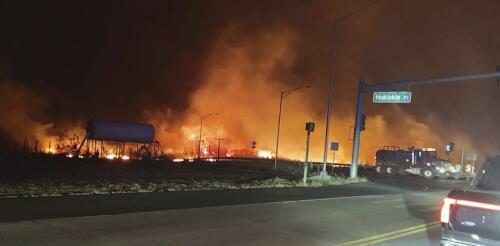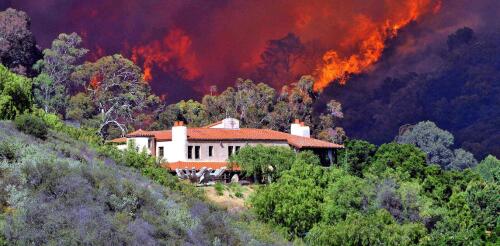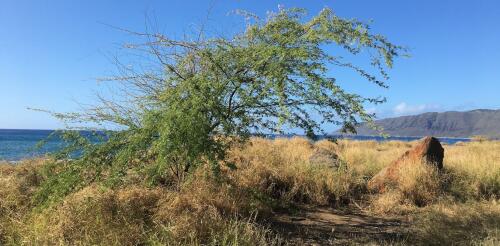Climate change
Wildfires, pushed by powerful winds, raced through Lahaina, Hawaii, on Aug. 8 and 9, 2023, leaving a charred and smoldering landscape across the tourist town of about 13,000 residents that was once the capital of the Kingdom of Hawaii. Nearly 100 people are believed to have died in the fires, Maui County officials said. Others were rescued by the U.S. Coast Guard after going into the ocean to escape the flames. Dry grasses and strong winds, influenced by Hurricane Dora passing far to the south, heightened the risk as wildfires burned both in Maui’s tourist-filled west coast and farther inland and on the Big Island of Hawaii. Most fires in the U.S. are suppressed before they have a chance to threaten communities, but the winds were too strong to send helicopters into the sky to help contain Maui’s fires on the first day, leaving firefighters to battle the blazes from the ground. Lt. Gov. Sylvia Luke issued an emergency declaration, activating the National Guard to he...
Humans have learned to fear wildfire. It can destroy communities, torch pristine forests and choke even faraway cities with toxic smoke. Wildfire is scary for good reason, and over a century of fire suppression efforts has conditioned people to expect wildland firefighters to snuff it out. But as journalist Nick Mott and I explore our new book, “This Is Wildfire: How to Protect Your Home, Yourself, and Your Community in the Age of Heat,” and in our podcast “Fireline,” this expectation and the approach to wildfire will have to change. Over time, extensive fire suppression has set the stage for the increasingly destructive wildfires we see today. The problem with fighting every fire The way the U.S. deals with wildfires today dates back to around 1910, when the Great Burn torched some 3 million acres across Washington, Idaho, Montana and British Columbia. After watching the fire’s swift and unstoppable spread, the fledgling Forest Service developed...
For three weeks in July, the world’s most elite bike racers climb steep mountains and sprint along historic cobblestones to capture the coveted yellow jersey or the race leader in the Tour de France. It’s a 21-day feat of human endurance that requires constant eating and drinking to manage the average daily energy demand of about 6,000 calories, equivalent to around 12 McDonald’s Happy Meals, and just over 1.5 gallons of water. Nearly 5,000 miles away in the mountains of North America, radios crackle with chatter from a wildfire incident command post, air operations and other crews fighting a wildfire. Up the fireline, the swings of Pulaskis, axlike hand tools, are carving a fuel break into the land. The weather forecast predicts a high of nearly 100 degrees Fahrenheit (38 C) with wind, a combination that can push the fire high up into the canopy of dense lodgepole pines on the mountainside. The yellow jerseys here are sooty, sweat-stained and flame-resistant...
The islands of Hawaii are world renowned for their generally pleasant and tranquil weather. However, the Aug. 8, 2023, wildfire tragedy on Maui was a stark reminder that Hawaii also can experience drought and hot, dry, windy weather, providing the conditions for destructive fires. Hawaii has seen a generally rising trend in the amount of land that burns each year as the local climate warms. Climate change was one of several contributors to Maui’s wildfire catastrophe, and rising temperatures and associated rainfall changes are expected to increase the islands’ fire risk. These changing weather patterns will also affect Hawaii’s ecosystems and freshwater resources. You can listen to more articles from The Conversation, narrated by Noa, here. I am a meteorologist at the University of Hawaii, and I have worked with colleagues to develop sophisticated computer climate simulations that project local rainfall changes over the 21st century. Our results sug...
Sixteen young Montanans who sued their state over climate change emerged victorious on Aug. 14, 2023, from a first-of-its-kind climate trial. The case, Held v. State of Montana, was based on allegations that state energy policies violate the young plaintiffs’ constitutional right to “a clean and healthful environment” – a right that has been enshrined in the Montana Constitution since the 1970s. The plaintiffs claimed that state laws promoting fossil fuel extraction and forbidding the consideration of climate impacts during environmental review violate their constitutional environmental right. Judge Kathy Seeley’s ruling in the youths’ favor sets a powerful precedent for the role of “green amendments” in climate litigation. The lawsuit, heard in Montana district court, was the first in the U.S. to rely on a state’s constitutional right to a clean and healthful environment to challenge state policies that fuel climate change...




